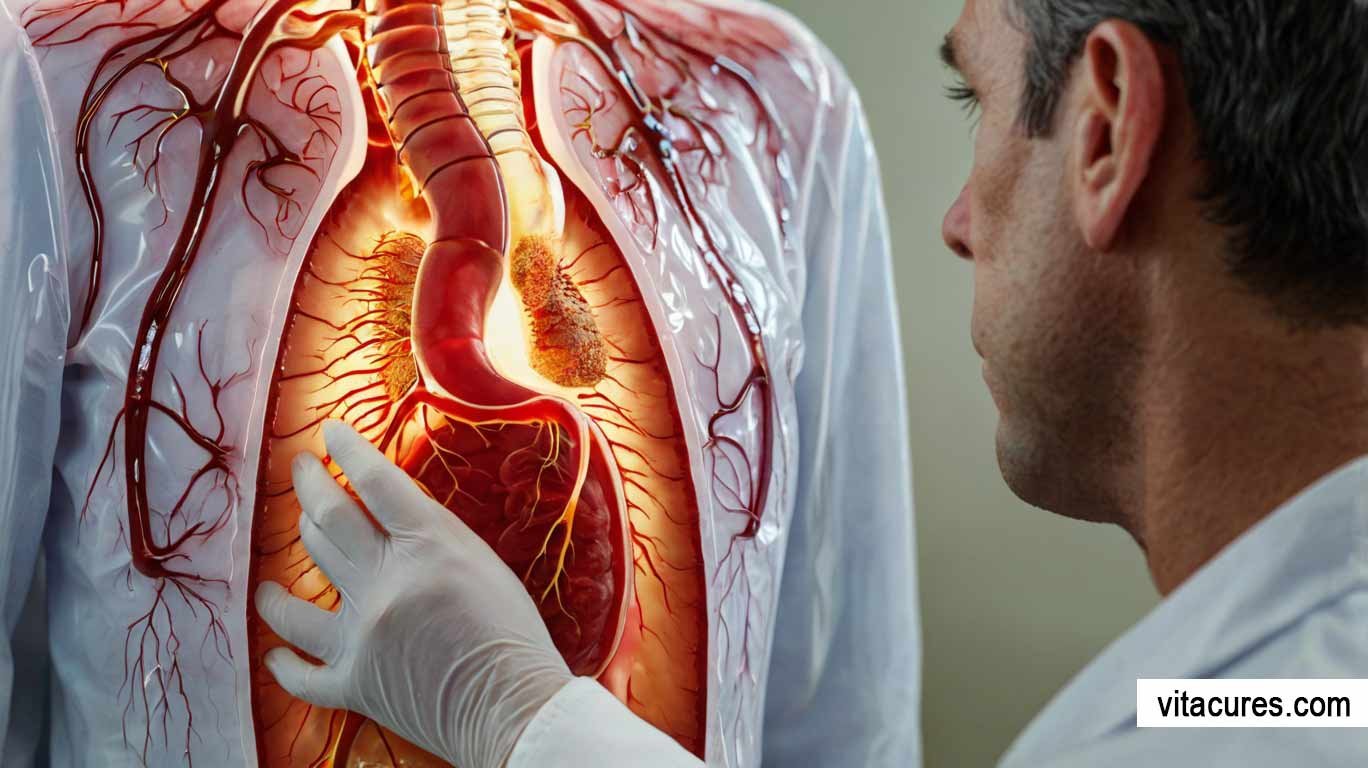Acid reflux, also known as gastroesophageal reflux disease (GERD), is a common digestive condition where stomach acid or bile irritates the food pipe lining. This detailed guide will cover the symptoms, causes, treatments, dietary modifications, and more to help manage and understand acid reflux.
What is acid reflux?
Acid reflux, also known as gastroesophageal reflux disease (GERD), is a medical condition in which stomach acids or sometimes bile flows back into the esophagus, the tube connecting the mouth to the stomach. This backwash can irritate the lining of the esophagus, causing unpleasant symptoms such as heartburn, regurgitation, and discomfort. It’s a common issue, affecting millions worldwide, ranging from mild irritation to severe daily disruption.
The primary mechanism behind acid reflux involves the malfunction of the lower esophageal sphincter (LES). This is a ring of muscle at the entrance to the stomach that normally tightens to prevent stomach contents from moving backward. However, if the LES is weak or relaxes inappropriately, acids can escape the stomach and enter the esophagus.
Lifestyle factors, dietary habits, and certain physical conditions can exacerbate acid reflux. These include obesity, lying down after eating, consuming large or fatty meals, and partaking in foods and beverages that are known to trigger reflux, such as spicy foods, chocolate, alcohol, and caffeine.
Recognizing and managing the symptoms through dietary changes, lifestyle modifications, and medications is crucial for those suffering from acid reflux to maintain their quality of life and prevent more serious complications such as esophageal damage or Barrett’s esophagus, a precancerous condition. With appropriate treatment, most people can manage the discomfort of acid reflux effectively and lead a healthy life.
Symptoms of Acid Reflux

The symptoms of acid reflux, also known as gastroesophageal reflux disease (GERD), can vary from mild to severe and may differ greatly from one person to another. Here are the most common symptoms associated with this condition:
- Heartburn: Usually manifesting as a burning sensation in the chest after eating, heartburn is the most recognizable symptom. It might worsen when lying down or bending over and can last from a few minutes to several hours.
- Regurgitation: This involves the sensation of acid backing up into your throat or mouth, producing a sour or bitter taste. In severe cases, it may result in a “wet burp” or even vomiting.
- Dyspepsia: Many people with acid reflux experience general stomach discomfort, which can include bloating, upper abdominal pain, nausea, and burping.
- Difficulty Swallowing (Dysphagia): Acid reflux can cause a narrowing of the esophagus, leading to sensations of food being stuck in your throat or tightening in your chest when you eat.
- Sore throat and hoarseness: When stomach acid reaches the throat, it can cause irritation, leading to a sore throat or hoarseness, which is particularly noticeable in the morning.
- Chronic Cough: A persistent, dry cough can be a symptom of acid reflux. It usually occurs as a reflex, with the acid irritating the lining of the throat or lungs.
- Asthma Symptoms: New or worsening asthma may occur if refluxed acid irritates the airways and lungs, which can affect breathing.
- Increased Salivation: Known as water brash, this symptom involves producing more saliva as a response to acid in the esophagus.
- Chest Pain: In some cases, acid reflux can cause chest pain that feels similar to a heart attack. It’s crucial to distinguish between the two, and we always recommend seeking immediate medical attention for chest pain.
Factors such as overeating, lying down after a meal, and consuming certain trigger foods can exacerbate these symptoms. Managing acid reflux typically involves lifestyle changes, dietary adjustments, and medications. Recognizing and understanding these symptoms is crucial for effective management and preventing potential complications.
Causes
Acid reflux, or gastroesophageal reflux disease (GERD), occurs when stomach acid, or occasionally stomach content, flows back into your esophagus. The causes of acid reflux involve a combination of lifestyle factors and physical conditions that affect the function of the lower esophageal sphincter (LES). Here are some of the primary causes:
- Lower Esophageal Sphincter (LES) Dysfunction: The LES acts as a valve between the esophagus and the stomach. If the LES is weak or relaxes inappropriately, it allows stomach acids to travel back up into the esophagus.
- Hiatal hernia: This condition occurs when the upper part of the stomach and the LES move above the diaphragm, a muscle that separates your stomach from your chest. Normally, the diaphragm helps keep acid in our stomach, but if you have a hiatal hernia, acid can move up into your esophagus and cause symptoms of acid reflux.
- Dietary Habits: Consuming large meals or lying down right after a meal can trigger acid reflux. Additionally, certain foods and drinks are known to contribute to reflux, including spicy foods, fatty foods, chocolate, caffeine, onions, citrus fruits, tomato sauce, and alcohol.
- Obesity or Overweight: Increased body weight can put additional pressure on the abdomen, pushing more acid into the esophagus.
- Pregnancy: During pregnancy, the increased hormone levels can cause the LES to relax, allowing acid to escape into the esophagus. Furthermore, the growing fetus can put pressure on the abdomen, pushing contents back up into the esophagus.
- Smoking and chewing tobacco: Both can affect the LES and stimulate stomach acid production, worsening acid reflux symptoms.
- Medications: Certain medications can relax the LES or increase acid production in the stomach, including anti-inflammatory drugs, certain asthma medications, antihistamines, painkillers, sedatives, and antidepressants.
- Delayed Stomach Emptying: In some cases, the stomach takes longer to empty its contents, which increases the likelihood of acid reflux.
Understanding these causes is crucial for managing acid reflux, as lifestyle changes and treatment plans often focus on adjusting these factors to improve symptoms.
Treatment

Treating acid reflux, or gastroesophageal reflux disease (GERD), involves a combination of lifestyle changes, dietary adjustments, and medications. The goal of treatment is to reduce the reflux of stomach acid into the esophagus, alleviate symptoms, and prevent complications. Here’s an overview of the common treatment strategies:
1. Lifestyle modifications
Making changes to your lifestyle is often the first step in treating acid reflux.
- Weight Management: Losing weight if you are overweight can reduce pressure on the stomach.
- Eating Habits: Eat smaller, more frequent meals instead of large meals and avoid eating close to bedtime.
- Elevate the Head of Your Bed: Raising the head of your bed by 6 to 8 inches can help gravity keep gastric acid down in your stomach.
- Avoid Trigger Foods and Drinks: Reduce intake of foods and drinks that trigger your symptoms, such as spicy foods, onions, citrus products, tomato products, fatty or fried foods, peppermint, chocolate, alcohol, caffeinated drinks, and carbonated drinks.
- Stop Smoking: It decreases the lower esophageal sphincter’s ability to function properly.
2. Medications
There are several types of medications available to treat acid reflux:
- Antacids: Over-the-counter medications that can quickly neutralize stomach acid and provide rapid pain relief.
- H2-Receptor Blockers: These medications reduce acid production. They do not act as quickly as antacids but provide longer relief.
- When reflux symptoms are severe or persistent, doctors often prescribe proton pump inhibitors (PPIs), which are stronger acid blockers than H2-receptor blockers.
- Prokinetics: This type of drug helps strengthen the LES, improve esophageal motility to clear acid from the esophagus, and increase the rate at which your stomach empties.
- Alginate Drugs: These form a foam barrier on top of the stomach contents to prevent acid reflux.
3. Dietary Adjustments
Dietary changes can significantly impact the frequency and severity of acid reflux.
- High-Fiber Diet: Fiber can help absorb stomach acid and reduce the likelihood of reflux.
- Alkaline Foods: Eating more alkaline foods like vegetables and low-acid fruits can help reduce stomach acidity.
- Watery Foods: Incorporating foods like cucumbers, watermelon, and herbal teas can help dilute and weaken stomach acid.
4. Alternative Therapies
Some people find relief through alternative therapies, but before trying these, it’s important to consult with a healthcare provider.
- Herbal Remedies: Studies have shown that herbs like ginger, chamomile, licorice, and turmeric can soothe the stomach and esophagus.
- Acupuncture: Some studies suggest that acupuncture might help reduce symptoms of acid reflux.
- Relaxation Therapies: Techniques like deep breathing, meditation, or yoga may reduce stress and therefore limit acid reflux episodes.
5. Surgical and endoscopic treatments
When lifestyle changes and medications fail to provide adequate relief in severe cases, one may consider surgical or other procedures.
- Nissen Fundoplication: A surgical procedure that increases pressure at the lower end of the esophagus.
- The LINX Device strengthens the closure of the LES by wrapping a ring of tiny magnetic beads around the junction of the stomach and esophagus.
- Endoscopic Techniques: Procedures like radiofrequency treatment can increase the strength of the LES.
The right treatment for acid reflux will depend on the severity and frequency of your symptoms and how well you respond to different treatments. A healthcare provider can help determine the most appropriate strategy for your specific condition.
Medicine
By reducing the amount of acid in the stomach, medications for acid reflux, also known as gastroesophageal reflux disease (GERD), aim to control symptoms, heal esophagitis, and prevent complications. Here are the most common types of medications used:
1. Antacids
Antacids provide quick relief by neutralizing stomach acid and can help manage occasional and mild symptoms of acid reflux. They are typically available over-the-counter and include:
- Aluminum hydroxide gel (Amphojel)
- Magnesium hydroxide (Milk of Magnesia)
- Calcium carbonate (Tums, Rolaids)
- Sodium bicarbonate (Alka-Seltzer) While effective for short-term relief, antacids do not heal inflamed tissue in the esophagus and can cause side effects like diarrhea or constipation if used frequently.
2. H2-Receptor Blockers
These drugs work by reducing the amount of acid the stomach produces and are effective for relieving and preventing moderate symptoms. They are slower-acting than antacids but provide longer relief. Examples include:
- Note: Many markets have recalled ranitidine (Zantac) due to safety concerns.
- Famotidine (Pepcid)
- Cimetidine (Tagamet)
- You can take nizatidine (Axid) H2 blockers before bed to reduce the production of acid at night.
3. Proton Pump Inhibitors (PPIs)
PPIs are the most effective medications for treating GERD. They block the enzyme necessary for acid secretion and are effective in healing esophageal damage. In severe cases, doctors typically prescribe them.
- Omeprazole (Prilosec)
- Esomeprazole (Nexium)
- Lansoprazole (Prevacid)
- Pantoprazole (Protonix)
- Usually, people take rabeprazole (Aciphex) PPIs once daily, 30 minutes before their first meal.
4. Prokinetics
These medications help strengthen the lower esophageal sphincter (LES) and make the stomach empty faster. Despite their less common use due to side effects, these medications can be beneficial for patients with significant reflux who have poor gastric emptying. Examples include:
- Metoclopramide (Reglan)
- Bethanechol (Urecholine) Prokinetics can have side effects such as fatigue, nervousness, and, in some cases, neurological issues.
5. Alginate Drugs
Alginate drugs such as Gaviscon form a foam barrier that sits on top of the stomach contents. This foam barrier helps prevent acid reflux by physically blocking the reflux of stomach contents into the esophagus.
Choosing the Right Medication
The choice of medication depends on the severity and frequency of symptoms, any underlying conditions, and individual response to treatment. It’s important to use these medications under the guidance of a healthcare provider, as they can interact with other medications and may have side effects. Long-term use, especially of PPIs, has been associated with an increased risk of vitamin B12 deficiency, bone fractures, kidney disease, and other potential issues, so it’s crucial to have a management plan that includes lifestyle modifications and possibly the lowest effective dose of medications.
Natural Remedies
Many people seek natural remedies to help manage acid reflux, also known as gastroesophageal reflux disease (GERD). While lifestyle changes and medications are the primary treatments, certain natural remedies can complement these efforts and provide relief. Here’s an overview of popular natural remedies for acid reflux:
1. Dietary Changes
One of the most effective natural ways to manage acid reflux is through dietary adjustments:
- Eat smaller, more frequent meals instead of three large meals.
- Avoid trigger foods and drinks such as caffeine, chocolate, alcohol, fatty foods, spicy foods, and acidic foods like tomatoes and citrus fruits.
2. Herbal Remedies
Several herbs are known for their potential to soothe the stomach and esophagus:
- Ginger: An anti-inflammatory that can help reduce stomach acid. It can be consumed as ginger tea or added fresh to foods.
- Chamomile: Known for its calming effects, chamomile tea can reduce inflammation in the esophagus and help calm acid reflux symptoms.
- Licorice: DGL (deglycyrrhizinated licorice) can help increase the mucus coating of the esophageal lining, which protects it from acid.
3. Aloe Vera Juice
Aloe vera can soothe the GI tract and has been shown to help decrease inflammation. It’s important to use a product specifically prepared for internal use.
4. Apple Cider Vinegar
Some people find relief from acid reflux by mixing a tablespoon of apple cider vinegar in a glass of water and drinking it before meals. However, this remedy is not scientifically proven and might worsen symptoms for some people due to its acidic nature.
5. Baking Soda
Baking soda (sodium bicarbonate) is a quick, homemade antacid that can neutralize stomach acid temporarily. Mix a teaspoon in a glass of water and drink it when you feel symptoms coming on. Be cautious with frequent use, as it can cause gas and diarrhea and affect your heart and kidneys.
6. Alkaline Water
Drinking water with a higher pH level than regular drinking water can help deactivate pepsin, the enzyme responsible for breaking down food proteins and producing stomach acid. This can reduce acid reflux symptoms.
7. Slippery Elm
This herb has been used historically to soothe inflammation in the throat and reduce symptoms of acid reflux. It can be consumed as a tea or in lozenge form.
8. Elevating the Head of the Bed
While not a consumable remedy, elevating the head of your bed can help keep stomach acid in the stomach due to gravity, especially during the night.
9. Mindfulness and Stress Reduction
Practices like yoga, meditation, and deep breathing exercises can reduce stress, which may exacerbate GERD symptoms in some individuals.
10. Chewing Gum
Chewing sugar-free gum after meals can help increase saliva production, which can help neutralize stomach acid and push acids back into the stomach.
List of foods to eat
Managing acid reflux often involves modifying your diet to include foods that are less likely to trigger symptoms. Here’s a list of foods that are generally considered safe and beneficial for people with acid reflux:
1. High-Fiber Foods
Fiber aids digestion and can help prevent the reflux of stomach contents. Incorporate a variety of fiber-rich foods such as:
- Whole grains: Oatmeal, whole grain bread, whole grain pasta, and brown rice.
- Root vegetables: Carrots, beets, and sweet potatoes.
- Green vegetables: Green beans, asparagus, broccoli, and leafy greens.
2. Lean Proteins
High-fat meals and fatty cuts of meat can provoke acid reflux. Opt for leaner protein sources like:
- Skinless poultry: Chicken and turkey breasts.
- Fish and seafood: Particularly those high in omega-3 fatty acids, like salmon, trout, and sardines.
- Eggs: Especially egg whites, which are low in fat.
- Legumes: Beans, peas, and lentils.
3. Low-Fat Dairy
Fat can be a trigger for acid reflux, so choosing low-fat dairy options can help:
- Low-fat or fat-free milk
- Low-fat or fat-free yogurt
- Low-fat cheeses, like mozzarella and feta
4. Non-Citrus Fruits
While citrus fruits can aggravate acid reflux, other fruits are less likely to cause symptoms:
- Bananas
- Apples
- Pears
- Melons such as watermelon, cantaloupe, and honeydew
5. Healthy Fats
Instead of foods with saturated and trans fats, opt for sources of healthy fats which are easier on the stomach:
- Avocados
- Nuts like almonds, walnuts, and pistachios
- Seeds such as flaxseed, chia seeds, and pumpkin seeds
- Olive oil and other vegetable oils in moderation
6. Herbal Teas
Herbal teas can be soothing to the stomach and esophagus:
- Ginger tea: Known for its gastrointestinal soothing properties.
- Chamomile tea: Can reduce stomach inflammation and aid relaxation.
- Licorice tea: Can help increase the mucus coating of the esophageal lining, protecting it from acid.
7. Watery Foods
Foods with high water content can help dilute and weaken stomach acid:
- Cucumbers
- Lettuce
- Broth-based soups
- Celery
8. Alkaline Foods
Eating more alkaline foods can help counteract the acidity in the stomach:
- Bananas
- Melons
- Cauliflower
- Nuts
By incorporating these foods into your diet, you can help manage your acid reflux symptoms and enjoy a wider variety of nutritious options. Always consult with a healthcare provider or a dietitian to tailor dietary choices to your specific health needs.
Diet chart for managing acid reflux
Creating a diet chart for managing acid reflux involves planning meals that are low in acid-producing ingredients and high in protective elements that soothe and maintain a healthy digestive system. Here’s a sample weekly diet chart designed to minimize acid reflux symptoms:
Monday
- Breakfast: Oatmeal with sliced bananas and a drizzle of honey.
- Mid-morning snack: A small handful of almonds.
- Lunch: Grilled chicken breast with steamed broccoli and quinoa.
- Afternoon snack: Low-fat yogurt with a sprinkle of flaxseeds.
- Dinner: Baked salmon with a side of mashed potatoes and green beans.
- Evening snack: Apple slices.
Tuesday
- Breakfast: Ginger tea with whole-grain toast topped with avocado.
- Mid-morning snack: A pear.
- Lunch: Turkey and spinach wrap in a whole wheat tortilla with mustard.
- Afternoon snack: Carrot sticks with hummus.
- Dinner: Stir-fried tofu with mixed vegetables (carrots, bell peppers, and zucchini) over brown rice.
- Evening snack: A small bowl of melon cubes.
Wednesday
- Breakfast: Smoothie with spinach, pear, banana, and almond milk.
- Mid-morning snack: A small bowl of watermelon.
- Lunch: Lentil soup with a side salad (lettuce, cucumbers, and shredded carrots with a light vinaigrette).
- Afternoon snack: Celery sticks.
- Dinner: Grilled turkey burgers (no bun) with a side of roasted sweet potatoes.
- Evening snack: Chamomile tea.
Thursday
- Breakfast: Scrambled egg whites with sautéed spinach and mushrooms.
- Mid-morning snack: A banana.
- Lunch: Baked cod with herbed couscous and steamed asparagus.
- Afternoon snack: A small handful of walnuts.
- Dinner: Pumpkin soup with a side of whole grain bread.
- Evening snack: Low-fat yogurt.
Friday
- Breakfast: Coconut milk yogurt with sliced strawberries and a sprinkle of pumpkin seeds.
- Mid-morning snack: Sliced cucumber.
- Lunch: Grilled chicken Caesar salad with low-fat dressing.
- Afternoon snack: An apple.
- Dinner: Shrimp stir-fry with bell peppers and brown rice.
- Evening snack: Ginger tea.
Saturday
- Breakfast: Oatmeal pancakes topped with fresh blueberries.
- Mid-morning snack: A small bowl of mixed berries.
- Lunch: Quinoa salad with grilled vegetables (eggplant, zucchini, bell pepper) and a drizzle of olive oil.
- Afternoon snack: A pear.
- Dinner: Pasta with pesto and peas.
- Evening snack: A small handful of pistachios.
Sunday
- Breakfast: Banana and honey smoothie.
- Mid-morning snack: Low-fat cheese slices.
- Lunch: Roast beef slices with roasted carrots and parsnips.
- Afternoon snack: A small bowl of cantaloupe.
- Dinner: Vegetable lasagna made with low-fat ricotta and mozzarella.
- Evening snack: Chamomile tea.
General Tips:
- Hydration: Drink plenty of water throughout the day to help dilute stomach acid and reduce acid reflux.
- Avoid late meals: Try to eat dinner at least three hours before bedtime to allow your stomach to empty before you lie down.
- Portion control: Avoid large meals that can put pressure on your stomach and LES, worsening reflux symptoms.
This diet chart is just a guideline, and individual tolerances can vary. Keeping a food diary can help you adjust this diet to better suit your specific dietary needs and preferences. For personalized advice, it’s best to consult with a dietitian.
What to do during an acid reflux attack?
An acid reflux attack, also known as a GERD flare-up, can cause significant discomfort and disrupt daily activities. Here’s what typically happens during an attack and how to manage it effectively.
Symptoms of an Acid Reflux Attack
An acid reflux attack can intensify the usual symptoms of GERD, which include:
- Severe heartburn: A burning sensation in the chest that might spread to your throat; sometimes accompanied by a sour taste in the mouth.
- Regurgitation: Feeling of acid backing up into your throat or mouth.
- Chest pain: Can occur, especially when lying down or bending over.
- Difficulty swallowing: Feeling as if food is stuck in your throat.
- Increased symptoms upon lying down: Many experience worse symptoms at night.
Managing an Acid Reflux Attack
When you feel an attack coming on, there are several steps you can take to alleviate the symptoms:
- Stand Up or Sit Up Straight: Gravity can help keep the stomach acids down. Avoid lying down during an attack as it makes it easier for acid to travel up the esophagus.
- Avoid Trigger Foods and Drinks: Steer clear of alcohol, caffeine, chocolate, fatty foods, spicy foods, and any other known triggers during an attack.
- Drink a Small Amount of Water: Sipping water can help wash the acid back down into the stomach. Avoid large quantities quickly as this can distend the stomach, potentially worsening reflux.
- -Chew Gum: Non-mint flavored gum can increase saliva production, which can help neutralize stomach acid and push acids back into the stomach.
- Take Antacids: Over-the-counter antacids can neutralize stomach acid and provide quick relief. Use them according to package instructions.
- medicationsprescribedUse Medications as Prescribed: If you have a quick prescription for a proton pump inhibitor (PPI) or an H2 blocker, continuing your medication regimen as prescribed can help manage your symptoms.
- Avoid Strenuous Activities: Heavy lifting or bending over can increase abdominal pressure, pushing stomach contents into the esophagus.
- Loosen Clothing: Tight clothing can constrict the abdomen, pushing stomach acids upwards.
Long-Term Management
To prevent future attacks, consider the following long-term strategies:
- Dietary Changes: Keep a food diary to identify and avoid foods that trigger symptoms.
- Weight Management: If overweight, losing weight can reduce pressure on the stomach.
- Eating Habits: Eat smaller, more frequent meals; avoid eating 2-3 hours before bedtime.
- Elevate the Head of Your Bed: Use a wedge pillow or raise the bed’s head by 6-8 inches to help keep acid in the stomach overnight.
When to Seek Medical Help
If acid reflux attacks are frequent, or if you experience severe pain, difficulty swallowing, persistent nausea, vomiting, or weight loss, it’s important to consult a healthcare provider. These could be signs of a more serious condition or complications from GERD.
Can you die from acid reflux in your sleep?
The likelihood of dying directly from acid reflux during sleep is very low, but severe untreated gastroesophageal reflux disease (GERD) can lead to potentially serious complications, some of which could be life-threatening if not managed properly.
Potential Complications of Severe GERD
- Aspiration Pneumonia: If stomach acid is aspirated (inhaled into the lungs) during sleep, it can cause respiratory issues and pneumonia. This is a serious condition that requires immediate medical attention.
- Esophageal Damage: Chronic exposure to stomach acid can lead to esophagitis (inflammation of the esophagus), esophageal ulcers, and in some cases, Barrett’s esophagus—a condition where the tissue lining the esophagus changes, increasing the risk of esophageal cancer.
- Sleep Disruption: Acid reflux can cause significant discomfort and interrupt sleep, leading to sleep apnea, a condition characterized by pauses in breathing during sleep. Severe sleep apnea itself is linked to a higher risk of heart disease, stroke, and other health issues.
Safety Measures and Treatment
To prevent the risk of acid reflux during sleep, consider the following steps:
- Elevate the Head of the Bed: Raising the head of your bed by about 6 to 8 inches helps keep stomach acid in the stomach due to gravity.
- Avoid Eating Before Bedtime: Try not to eat for at least three hours before going to bed.
- Maintain a Healthy Weight: Excess weight can increase abdominal pressure, exacerbating GERD symptoms.
- Avoid Alcohol and Smoking: Both can relax the lower esophageal sphincter, making it easier for stomach acid to reflux.
- Manage Diet: Avoid foods and drinks that trigger your reflux symptoms, like fatty foods, coffee, and chocolate.
When to Seek Medical Help
If you often experience severe acid reflux at night or have symptoms like choking, coughing, wheezing, or frequent awakenings due to heartburn, it’s important to consult a healthcare provider. They can assess your condition, rule out more serious issues, and potentially prescribe medications or recommend other interventions to manage the condition effectively.
The throat How to get rid of acid reflux in throat fast?
Acid reflux in the throat, often experienced as a burning sensation or irritation, can be uncomfortable and disruptive. Here are some effective strategies to quickly alleviate acid reflux symptoms in the throat:
1. Antacids
Over-the-counter antacids can provide quick relief by neutralizing stomach acid. Products containing calcium carbonate or magnesium hydroxide are commonly used to ease the burning sensation in the throat.
2. Drink Water
Sipping water can help wash the acid back down into the stomach and dilute any acid in the throat, providing immediate relief.
3. Chew Gum
Chewing sugar-free gum stimulates saliva production, which can help neutralize and clear acid from the esophagus and throat.
4. Baking Soda
A teaspoon of baking soda mixed in a glass of water can help neutralize stomach acid. This should be used sparingly, as baking soda is high in sodium and can cause side effects like bloating and gas.prescribed
5. Avoid Trigger Foods
Stay away from foods and drinks that trigger your reflux symptoms, such as spicy foods, fatty foods, citrus fruits, tomato-based products, chocolate, caffeine, and alcohol, especially close to bedtime.
6. Eat Smaller, More Frequent Meals
Large meals can increase stomach pressure and the likelihood of acid reflux. Smaller, more frequent meals help minimize this risk.
7. Elevate the Upper Body
When lying down, elevate your upper body with extra pillows or a wedge pillow. This positioning can help keep stomach acid in the stomach, especially during the night.
8. Avoid Tight Clothing
Tight clothing, especially around the abdomen, can push stomach contents back up into the esophagus. Wear loose-fitting clothes to ease symptoms.
9. Alkaline Water
Drinking water with a higher pH than regular drinking water can help deactivate pepsin, the enzyme responsible for breaking down food proteins and a common cause of acid irritation in the throat.
10. Herbal Remedies
Herbal teas, like ginger tea, chamomile tea, and licorice root tea, can provide soothing relief for the throat.
What does acid reflux feel like?
Acid reflux, commonly experienced as a part of gastroesophageal reflux disease (GERD), can manifest a range of symptoms that might vary from person to person. Generally, here’s what acid reflux feels like:
- Heartburn: This is the most common symptom and feels like a burning sensation in the chest, just behind the breastbone. It typically occurs after eating and can last for a few minutes to several hours. The discomfort may worsen when lying down or bending over.
- Regurgitation: This involves a sour or bitter taste in the mouth when stomach acids flow back up into the throat or mouth. It can sometimes result in a “wet burp” or even vomiting of small amounts of food.
- Dyspepsia: This is a general term for stomach discomfort. Symptoms of dyspepsia include burping, nausea after eating, bloating, and upper abdominal pain or discomfort.
- Throat Issues: Acid reflux can cause a chronic sore throat or chronic cough, a hoarse voice, or a feeling that something is stuck in the throat.
- Difficulty Swallowing (Dysphagia): Some people feel like food is sticking in their esophagus while eating. This isn’t a typical occurrence and can indicate more severe esophageal damage or scarring.
- Increased Salivation: More commonly known as water brash, where there is a sudden appearance of a lot of saliva in your mouth that isn’t triggered by eating or thinking about food.
- Chest Pain: Occasionally, especially when lying down, you might experience chest pain or discomfort that can feel similar to the pain associated with heart disease or a heart attack.
Triggered or Worsened by:
- Eating large meals or lying down right after a meal.
- Bending over at the waist or lying on your back.
- Snacking close to bedtime.
- Eating certain foods such as onions, citrus fruits, peppermint, chocolate, high-fat foods, or spicy foods.
- Drinking certain beverages, like alcohol, carbonated drinks, coffee, or tea.
- Smoking or exposure to secondhand smoke.
If you frequently experience these symptoms, it might be beneficial to consult a healthcare provider to discuss diagnosis and treatment options, as effective management can greatly improve your quality of life.

FAQ’s
Here are some frequently asked questions (FAQs) about acid reflux, which provide a succinct overview of the key points surrounding this common condition, along with their answers:
1. What is acid reflux?
Answer: Acid reflux, also known as gastroesophageal reflux (GER), occurs when stomach acid flows back up into the esophagus, the tube connecting the mouth to the stomach. This backwash can irritate the lining of your esophagus and cause discomfort.
2. What are the symptoms of acid reflux?
Answer: The most common symptoms include heartburn (a burning sensation in the chest), regurgitation of food or sour liquid, and difficulty swallowing. Other symptoms can include a chronic cough, laryngitis, new or worsening asthma, and disrupted sleep.
3. What causes acid reflux?
Answer: Causes include a dysfunctional lower esophageal sphincter, obesity, lying down or bending over after eating, pregnancy, eating certain foods (like spicy or fatty foods), and consuming specific beverages (such as alcohol or coffee).
4. How is acid reflux treated?
Answer: Treatment usually involves lifestyle changes such as losing weight, avoiding alcohol, not smoking, and not eating late at night. Over-the-counter medications may include antacids, H2 blockers, or proton pump inhibitors. In severe cases, prescription medications or surgery might be necessary.
5. Can diet affect acid reflux?
Answer: Yes, diet plays a significant role in managing acid reflux. It is beneficial to avoid trigger foods and beverages like spicy foods, onions, citrus fruits, chocolate, and alcohol. Eating smaller, more frequent meals can also help.
6. Are there any home remedies for acid reflux?
Answer: Home remedies for managing acid reflux include drinking ginger tea, eating smaller meals, elevating the head while sleeping, and avoiding eating right before bed. Alkaline water and chewing gum can also neutralize stomach acid.
7. When should I see a doctor for acid reflux?
Answer: You should consult a doctor if you experience severe, frequent, or persistent symptoms of acid reflux, or if over-the-counter medications do not relieve your symptoms. It’s also important to seek professional help if you have difficulty swallowing, unintentional weight loss, or chronic sore throat.
References for Further Reading:
- American College of Gastroenterology: Provides guidelines and articles about the latest treatment options and research on gastroesophageal reflux disease.
- Mayo Clinic: Offers comprehensive information on symptoms, causes, diagnosis, and treatment of acid reflux.
- National Institute of Diabetes and Digestive and Kidney Diseases (NIDDK): Features detailed articles about the causes, prevention, and treatment of GERD.
- WebMD: An accessible source for tips on managing acid reflux through lifestyle changes and home remedies.
- Healthline: offers diet and lifestyle advice specifically for those suffering from acid reflux.
These resources can provide further detailed information and help you manage acid reflux effectively. Always consult with a healthcare professional for personalized advice and treatment options.



